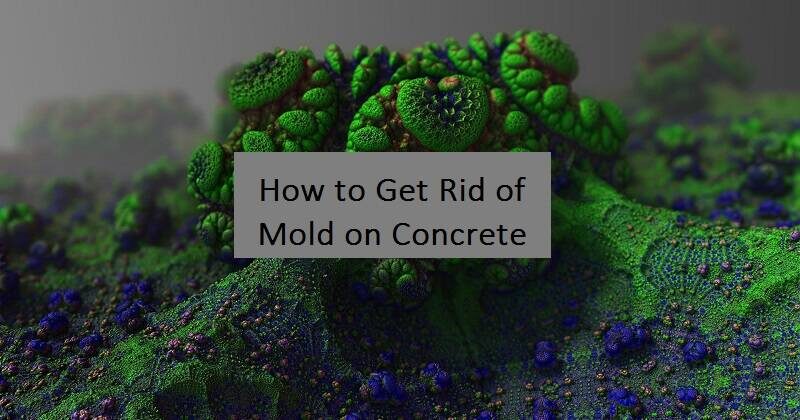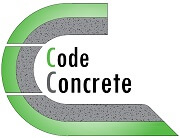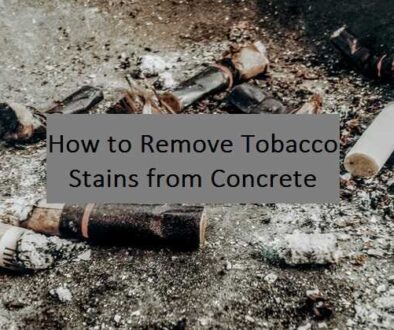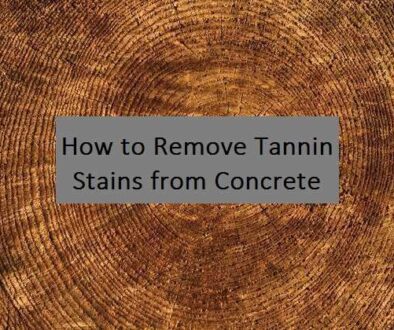How to Get Rid of Mold on Concrete

Last updated on October 12th, 2023
Mold is a fungal growth that thrives on organic matter, and can be of different types. Also, mold can be of different colors including white, grey, black, greenish, and many others. However, the types and characteristics of mold is beyond the scope of this article.
In fact, mold issues are common on concrete basement walls, closed unvented areas, highly humid or continuously wet surfaces, block walls, concrete patios, etc. But these fungal growths are not only aesthetically unappealing, but can also impose health risks to living beings. Thereby, it is important to know how to deal with such issues, and how to implement the best removal methods.
Accordingly, this article addresses some of the ideal methods on how to get rid of mold on concrete, and discusses important considerations and preventive measures. However, before getting into the removal methods, let us first briefly explain about mold.
How and why does mold grow on concrete surfaces?
Mold can only grow if a certain encouraging environment with its essential components are present. Basically, we are referring to temperature, humidity, water, food, and oxygen, in addition to others. However, this does not mean that mold cannot be present if all these components are not. In fact, some spores may survive and be in an inactive state until the right environment is present for their growth and spread.
But can concrete surfaces provide such an environment? Well concrete is a porous material, just imagine it as a sponge with porous structure and voids. Thereby, it can easily hold moisture, which is actually one of the most common reasons for mold and mildew to grow. Moreover, some components in coatings or paints, in addition to dust and other organic matter, can provide the “food” requirements for these fungal growths. Based on this, mold not only can be present on the surface, but can actually grow deep down the pores of concrete.
Why it is important to get rid of mold and mildew from concrete?
Mold and mildew can impose health issues to human beings. For example, the United States Environmental Protection Agency (EPA) discusses how mold can affect people, and states that it can cause allergic reactions and irritations, especially for sensitive people. These include, but not limited to, skin rash, red eyes, sneezing, runny nose, and throat and lung irritations.
Preventive measures
Accordingly, it is important to treat issues related to mold as soon as possible. However, a more important consideration is to take preventive measures to avoid having mold issues at the first place. Thereby, one of the most effective “preventive” methods is to make sure you do not create the ideal environmental conditions which trigger or promote the growth and spread of mold. For example, these include controlling the humidity and temperature, and fixing any moisture issues or water leaks indoors, in addition to proper hygienic practices. For outdoor concrete, preventive measures may include routine cleaning, application of a sealer, reduction of water or moisture exposure through proper drainage for instance, etc.
In fact, it is always preferable to take preventive measures instead of dealing with routine mold cleaning and removal methods. Besides, even if mold grows and spreads, it is important to find a solution for the cause, and not simply remove the mold. This is especially true because if the promoting environment is still present after the removal, it is likely for the mold to reappear sooner or later, especially if the spores are still present.
How to get rid of mold on concrete: The ideal cleaning methods
In this article, we will present various effective methods for the removal of mold from concrete surfaces.
Method #1: How to get rid of mold on concrete using household products

This method is simple yet effective, and only requires readily available household products.
Things you will need
- Water.
- Safety gear.
- Either chlorine bleach /or a mixture of laundry detergent, tri-sodium phosphate, laundry bleach, and water.
- Stiff bristle broom.
- Pressure washer – optional.
Notes
- Chlorine bleach is a liquid that consists of sodium hypochlorite, water, and other chemicals.
Appearance: Slightly yellowish or colorless.
Availability: It is a household product and available at the supermarkets.
Hazards: It is corrosive to flesh, and can react with other chemical to produce a toxic gas. - Trisodium Phosphate is also known as Sodium Orthophosphate, TSP, and Phosphate of Soda.
Appearance: White crystalline odorless powder.
Availability: It is available at the supermarkets.
Hazards: This compound is also corrosive to flesh.
Steps
- Wear your Safety gear.
- Wet the surface with clean water, or pressure wash it.
- Either apply chlorine bleach uniformly, or apply a mixture of laundry detergent, tri-sodium phosphate, bleach, and water (1 : 3 : 32 : 96).
- Use the stiff bristle broom to vigorously scrub the surface.
- Rinse and flush the surface, or pressure wash it.
- Use the stiff bristle broom to scrub off any dead fungal growth that appears within a couple of days.
- Rinse and flush the surface, or pressure wash it.
- Repeat as needed.
Explanation
First, put on your protective gear to ensure your safety. Second, wet the surface or pressure wash it if the equipment is available. In fact, pre-wetting the surface is an important step before the application of the bleach. Third, uniformly apply chlorine bleach to the surface, or apply a mixture of 1 part laundry detergent with 3 parts of TSP, 32 parts of bleach, and 96 parts of water, which is highly effective for mildew. Then, scrub the surface vigorously using a stiff bristle broom. Make sure to work in different directions or circular motion for a more effective outcome.
Next, rinse and flush the surface with clean water, or use a pressure washer. Dead fungal growth may appear with a few days after this treatment. In this case, you should scrub with a stiff bristle broom and flush with clean water, and pressure wash the surface. You can repeat this process if you missed any areas, or as needed.
Method #2: How to get rid of mold on concrete with special mold removers or fungicides

This is one of the simplest yet most effective methods to get rid of mold from concrete. However, it is important to have the right product.
Things you will need
- Follow the manufacturer’s instructions.
Explanation
Using special products or fungicides is highly effective, since such agents are generally tested and approved. In addition, they are mostly easy to use and some even do not require vigorous scrubbing or too much elbow grease. However, there are plenty of products in the market, and not all are equal. Some can kill mold and their spores, some cannot, and some are highly effective in cleaning the stain behind molds and mildew. Thereby, it is important to select an approved high quality product, and follow the manufacturer’s instructions for the use and safety precautions.
Method #3: How to get rid of mold on concrete using steam cleaning

This method requires the use of a high temperature steam cleaner, which can be highly effective in killing most types of mold.
Things you will need
- Safety gear.
- Steam cleaner.
- Water.
Explanation
High temperature steam cleaning can have various advantages over other methods, and is actually one of the most effective methods. Basically, such cleaners can produce steam with a temperature exceeding 300 degrees Fahrenheit, or about 150 degrees Celsius. In fact, this temperature is sufficient to kill almost all types of mold and their spores; knowing that the most common types of mold on concrete won’t survive at a temperature above 150 degrees Fahrenheit, or about 60 degrees Celsius. Thereby, this makes high temperature steam cleaning highly effective. In addition, this method is not harsh to the concrete surface, unlike other methods which involve the use of strong chemicals or acids. Moreover, dry steam cleaning, which is a type of steam cleaning that only uses a small amount of water to produce steam, can be even more preferable since it does not saturate the surface with water.
Frequently asked questions
Can I use sugar soap for the removal of mold?
Phosphate-based cleaning agents including sugar soap can be helpful in cleaning mold, but they do not kill mold or its spores.
Will vinegar kill mold?
Yes, vinegar can kill many types of mold. However, for the removal of mold from concrete surfaces, you should take into account the acidity of the vinegar. In fact, exposing concrete to acidic solutions can damage the surface, in particular etching it.
Can I use CLR to remove mold from concrete?
CLR can be highly effective, and there are special CLR products for the removal of mold and mildew.
Can you remove mildew from concrete without bleach?
The short answer is yes. We presented different methods and discussed alternatives which do not involve the use of bleach, such as steam cleaning.
How do you remove mold permanently?
In brief, the most effective method to get rid of mold problems permanently is to:
- Clean or remove the mold.
- Determine the main cause or promoter for mold growth and spread.
- Find a solution for this cause in order to cut off the mold promoting environmental conditions. Or simply, follow the preventive methods.
Sometimes, people just deal with removing the mold, and do not consider finding a solution to the main cause. However, this generally leads to a temporary solution only.
Final thoughts
Mold and mildew issues are common, however understanding the basic promoters for these microorganisms and the ideal preventive and removal methods can help avoiding them. This article presented most of the essential details, and provided the best removal methods which are proven and effective.




